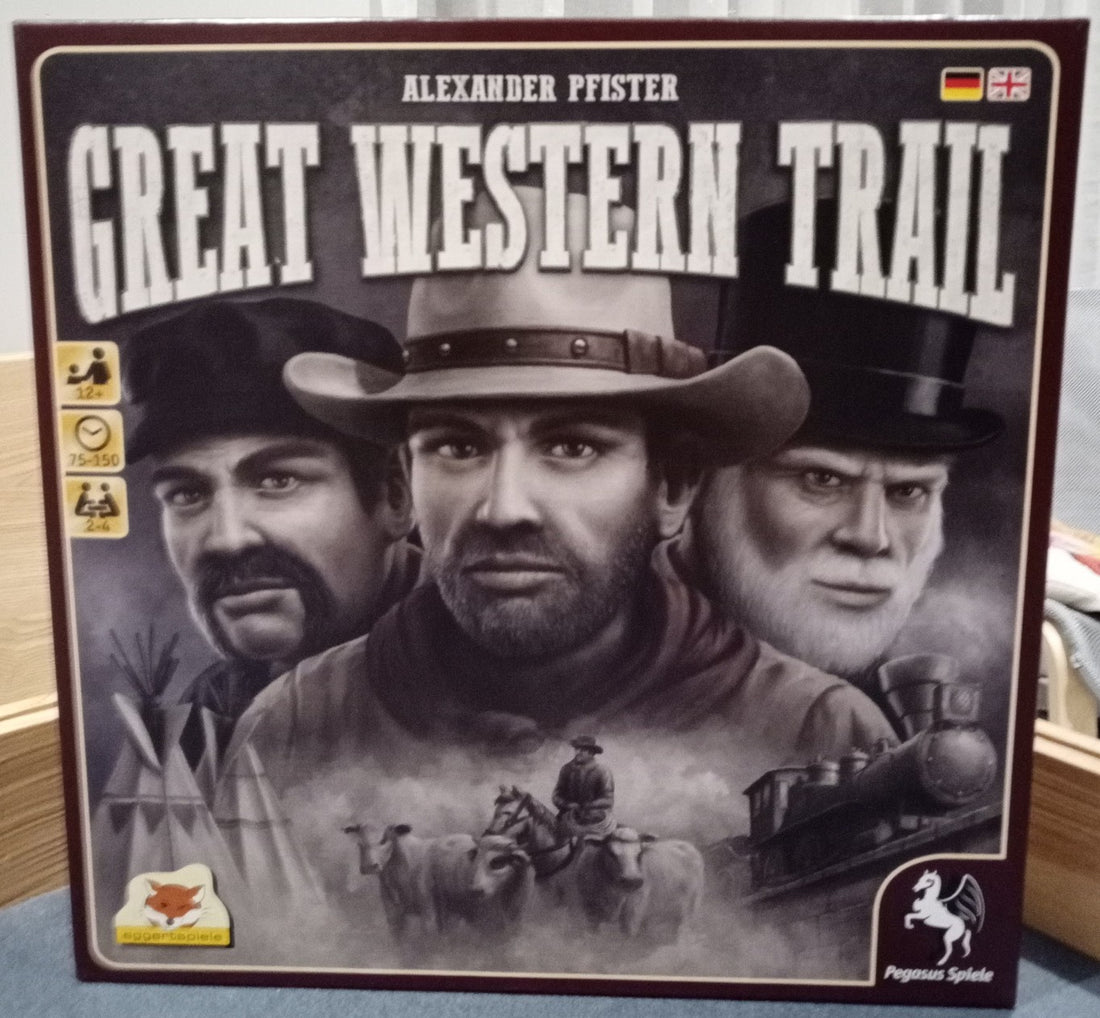As the Meeple Design website has been live for some time now we thought it was about time we added the obligatory 'favourite board games' post. It should give an idea about our thought process behind buying new board games and hopefully a bit of insight into why we started Meeple Design. This will be for my top 5 games and Hannah will write her own list for her top 5 games. I am sure the list will be different and even if there are crossovers I think the reason we like the games will vary as well.
It is difficult to pick my favourite 5 games, as there are so many that I enjoy playing and a few that I need to play more of before I can confidently say they are among my favourite games. The 5 games that I have picked are partly because they play well with 2 players and I play most often with 2 players, even pre-pandemic. It is quite clear from the 5 games that I have picked that I am a big fan of euro style games.
In order to provide a bit more detail about each game and why I like it, I will be publishing an article for each game (Check out the other articles on our blog page). They are in no particular order as it was difficult enough to narrow down to only 5 games. My top 5 games are:
Great Western Trail came out the same year as Terraforming Mars, so had a lot of competition, and both games were in a lot of peoples 'top 10 of the year'. Actually the reason I was aware of it and purchased it, was due to it being featured on Man vs Meeples top 10 list of 2016. Although very different games, the one thing they share in common is that they are fairly heavy Eurogames which, in my opinion, have a stronger theme than a lot of other heavy Euro games.
It is set in the Old West but the focus isn’t about bank robbing and shootouts, instead you take control of a Cowboy Rancher who is driving herds of cattle across the Great Plains of America to Kansas City. Selling the cattle at Kansas and then repeating the process all over again. Like other good euro games it uses the theme to perfectly blend it’s main mechanics of; tile placement, building management, point-to-point movement, and worker management, together. Each of the separate mechanics are not too complex to teach or understand in isolation but learning the iconography, how they interlock together and the number of different mechanics, is not an easy task which means that GWT is certainly not a gateway game. However the whole game is about repeating a loop from the start of the board to Kansas, optimising your engine round by round. Therefore despite the multiple decisions you have to make during the game it never throws everything at you at once reducing the likelihood of Analysis Paralysis and after the first loop it starts to become more intuitive, so that by the end of your first game you feel like you have a stronger understanding of the rules compared to other similar heavy games.

So what do you actually do during each loop around the board? Every player starts each game with an identical deck of cattle cards with the aim of the game to make it to Kansas with as many different breeds of cattle as possible, where you send them off to another city by train. The central part of the board being the key element that you move around during each loop. Each turn you can move your cattlemen 3 spaces along a simple pathway with several diverging routes. Each space is determined by whether there is a building, hazard or Native American reservation on the board so you can simply ignore empty spaces. These spaces slowly fill up over the course of the game with additional player-purchased ‘private’ buildings and hazards & Native American reservations at the end of each loop. Stopping on the buildings allows you to take actions such as selling cards, adding more buildings to the board, advancing your train on the top track of the board, recruiting staff, acquiring objective cards to earn additional points and improving the quality of your cattle breeds.
It is the building stops along the board that allow players to work towards their point scoring objectives. Improving their engine little by little each time they make another journey to Kansas. Along the route are neutral buildings that can be used by all players and private buildings, of which each player has a stack of 10, allow only the player that placed them to take the action associated with the building. Any other player that stops at another player owned building can only take basic actions, of which there are several, which can be improved throughout the course of the game, and they may also have to pay money to their opponent for the privilege of being let past. Placing buildings along your route essentially improves your engine throughout the course of the game giving you more options and potential stops. Also along the route you might encounter hazards (rockfalls or floods) or Native Americans both represented by tiles that in most cases, cost money to pass.
Every player starts identically with the same cards, buildings available and their own player board. The individual player board is where players; recruit workers improving the actions you can take moving around the board and allowing you to take one time special actions (which with clever play you can actually use multiple times) and can purchase upgrades such as increasing movement, improving your basic actions or increasing your deck limit. Like with other aspects of the game there is a seemingly daunting amount of iconography which is actually intuitive once you get used to it as it is used across all aspects of the game.
The final, and in some ways most important, aspect of the game loop is your train represented on the train track at the top of the board. Throughout the course of the game you can take multiple actions to move your train along the track with the option to move into stations which allows you to give up one of your enquired engineer workers for permanent bonuses and additional end game scoring goals. Once your cowboy finishes his long and probably arduous journey, avoiding rocks and making sure his cattle isn’t stolen, then you end up at Kansas city. The different breeds of Cattle you have in your hand at this point determines how far along the train track you can transport them, however if your train hasn’t reached that city then you have to make up the difference in stops in revenue deducted from the sale of the Cattle. Where do the Cattle go once they arrive at their destination? Lets just say they go to a loving home and leave it at that!
It is arriving at Kansas which adds new hazards and Native Americans onto the board as well as workers to the marketplace which in turn progresses the game towards the final round. GWT is definitely a point salad style game with our games typically ending over 100 points per player.
The variation of mechanics had the potential to muddle the game, bogging it down in different systems causing Analysis Paralysis but I found them to blend together perfectly being well balanced. The game progresses quickly and the end creeps up suddenly on you. However it is also perfectly timed from the point of view that it allows you to build your engine making use of it fully for a loop of the board. I love the fact that there are different elements that you can choose to focus on but unlike some other Euro games you aren’t penalised if you don’t choose to focus on a single aspect. Another aspect of this game that I feel is underrated is that often the rules for heavy Euro games are difficult to grasp until you have played 2 or 3 times. Not so with Great Western Trail, due to the gameplay loop you quickly learn the rules and mechanics, as you are repeating the same actions round to round while adding on additional nuances as the game progresses. After the initial slog of getting through the rule book, my wife & I were able to gain a solid grasp of the rules by the end of the first game which doesn’t always happen with us. Lastly for a Euro game the theme and mechanics fit surprisingly well together which isn’t to say that a different theme couldn’t be wrapped around it but I find it difficult to imagine what would work as well as being a Rancher.

Despite being in my top 5 there are negative aspects to the game. The player board is annoying and if you nudge the table it could send the markers on the board flying, having you struggling to remember where they were placed. Maybe more egregiously for some people, is the brutal scoring (at least at 2 player count)! Point scoring is hidden throughout the game with no scoring tracker around the edge of the board like in many other Euro games. This should make for some nail biting conclusions while everyone is tailing up their scores however, in reality, you often have a good idea around ¾ of the way through regarding who has won and the slightest misstep can cause a big difference in end game scoring. This isn’t to say that you never have tight conclusions. For Hannah and I, this isn’t an issue as the action of playing Great Western Trail regardless of winning or losing is hugely fun for us. Plus, as a positive for Hannah, it is usually me that loses! So I guess I just need to improve my game play (although that probably applies to Board Games in general rather than being limited to Great Western Trail). I would recommend that anyone who is a fan of Euro games should play Great Western Trail at least once and if you like it there is always the expansion to add to your collection as well, which we have yet to play.
As fans of Great Western Trail we have created our own Meeple Design Minimalist travel style and silhouette posters to decorate your gaming space with, as well as unique apparel designs to wear to your board game sessions. All of which are available exclusively from Meeple Design - check them out here.
**Our blog is supported by fans of Meeple Design. If you buy through a link, we may earn an affiliate commission.**




